The North Carolina State Board of Elections (NCSBE) certified the March 5 primary during a board meeting Tuesday.
More than 1.8 million ballots were cast, or 24% of the over 7.4 million registered voters. That’s down from the 2020 primary when over 2.1 million ballots were cast or 31% of the over 6.9 million voters that were registered then.
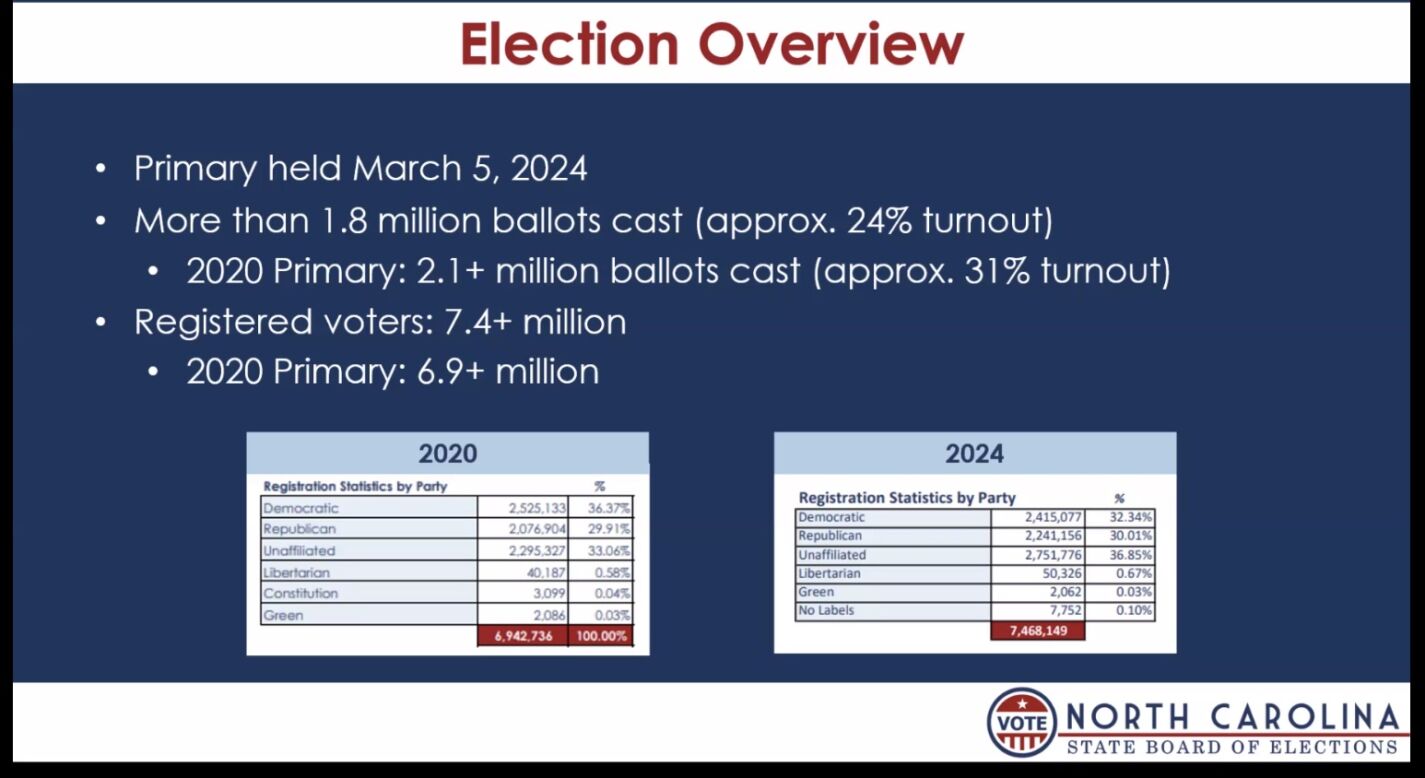
This was also the second time North Carolina was a Super Tuesday state.
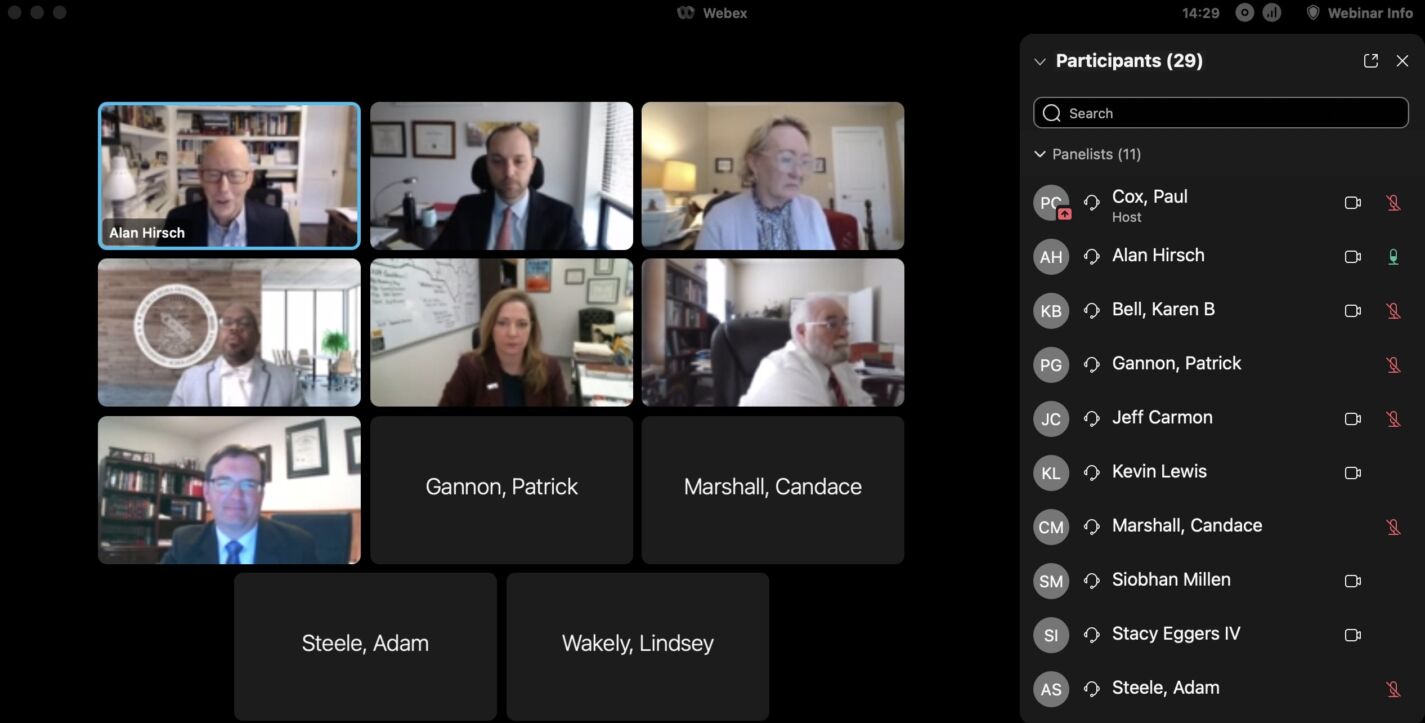
NCSBE Executive Director Karen Brinson Bell said that since the 2020 election, the number of registered voters who are affiliated with the Democratic Party has gone down while the number of Republican and Unaffiliated registered voters has gone up, with the most notable jump for unaffiliated. The totals are as follows:
2020 – Democrat – 2,525,133, 36%. Republican – 2, 076,904, 30%. Unaffiliated – 2,295,327, 33%. Libertarian 40,187, 0.58%. Constitutional – 3,099, 0.04%. Green – 2,086, 0.03%.
2024 – Democrat – 2,415,077, 32%. Republican – 2,241,156, 30%. Unaffiliated – 2,751,776, 37%. Libertarian – 50,326, 0.67%. Green – 2,062, 0.03%. No Labels – 7,752, 0.10%.
She said there was a slight uptick in the number of people who chose to vote by absentee by mail this year, 27,872, compared to 2020, which saw 26,514, and early voting was down, but so was the turnout. Over 671,000 voted in-person early voting compared to 779,254 in 2020, while over 1.1 million voted on Election Day this year, and over 1.29 million voted in 2020’s primary.
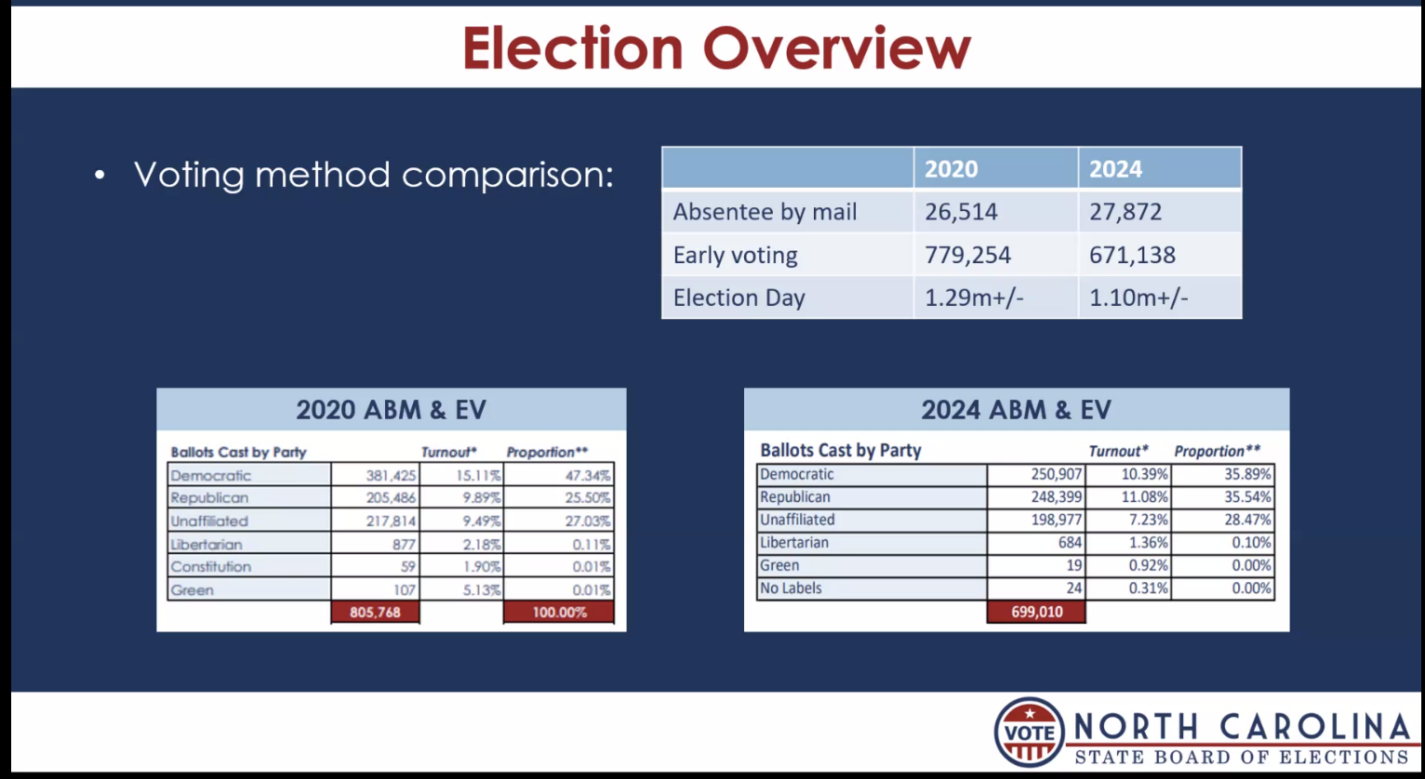
Normally, Democrats are noted for early voting and voting by mail over Republicans, but that wasn’t the case in this year’s primary. Brinson Bell said there was a 10% uptick of Republicans choosing to vote absentee by mail or in early voting, along with a slight rise for unaffiliated, while Democratic voters decreased in those areas.
2024 – Democrat – 250,907, 10% – turnout, 47%. Republican 248,399, 11%.- turnout Unaffiliated – 198,977, 7% – turnout. Libertarians – 684, 1.3% – turnout. Green – 19, 0.92% – turnout. No Labels – 24, 0.31% – turnout. Total – 699,010.
2020- Democrat – 381,425, 15% – turnout. Republican – 205,486, 10% – turnout. Unaffiliated – 217,814, 9% – turnout. Libertarian – 877, 2% – turnout. Constitution – 59, 2% – turnout. Green – 107, 5% – turnout. Total – 805,768. .
She noted that even though Voter ID was implemented in the General Election in November, this was the first large-scale use of it.
“We were just short of 1200 (1,185) voters who cast a provisional ballot for a reason related to photo ID, so that breaks down to about 6.6 out of every 10,000 ballots that were cast,” Brinson Bell said. “We were able to count 697 of these provisional ballots that were related to photo ID, so that’s about a 59% acceptance rate.”
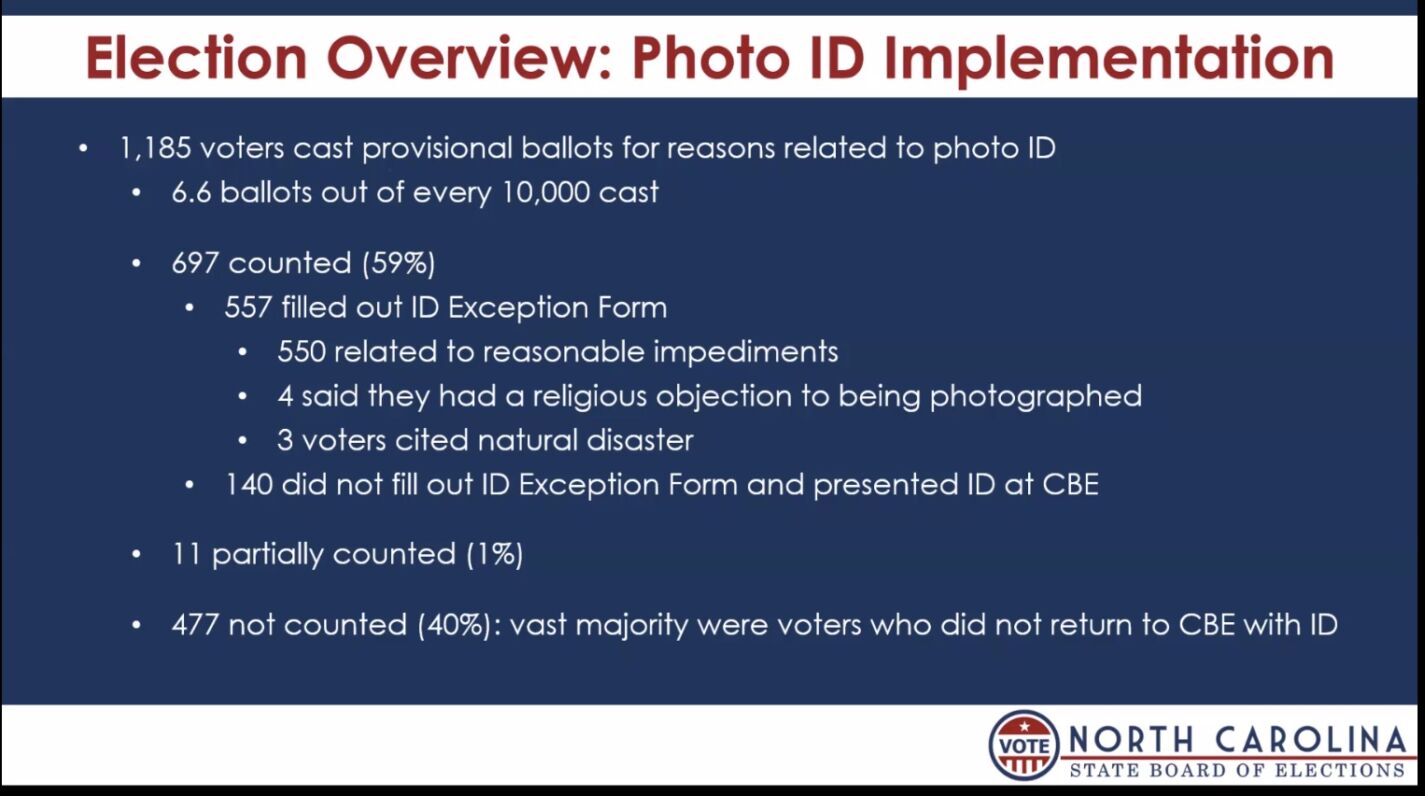
The numbers ended with 557 filling out an ID exception form and casting their ballot provisionally. Reasonable impediment was listed for 550 voters. Four noted religious objections to being photographed, and three voters cited natural disaster. 140 people voted provisionally but without an ID exception form because they indicated that they did not have a proper ID, so they voted provisionally and then returned to the county Board of Elections to present their ID during the canvas. There were 11 provisional ballots, or 1% related to photo ID, that were counted partially, meaning they were not in the proper precinct on election day, and there were contests on that ballot that were not within their jurisdiction. NCSBE was, however, able to partially count those within their voting jurisdiction.
Also, 477 provisional ballots related to ID were not counted. And the vast majority were voters who did not return to the county Board of Elections with an ID during the canvas.
The deadline for absentee by mail was also changed for the primary election.
In previous years, the absentee ballot would be accepted and counted if it was postmarked by Election Day and received within three days after the election.
For the 2024 primary, the absentee ballot had to be received at the county board of election by 7:30 pm on Election Day.
In 2020, there were 800 ballots that were not counted that came in after the deadline. In 2024, 1128 ballots came in after the Election Day 7:30 pm deadline.
Brinson Bell said the provision for those in the military and citizens who are overseas is still in effect, and they can have their ballots counted after Election Day.
Next, they discussed the Voter History Audit, which is designed to identify significant discrepancies that could be a sign of election fraud, such as ballot stuffing, fraudulent manual entries, or tampering with media cards. It can also identify certain ballot coding errors.
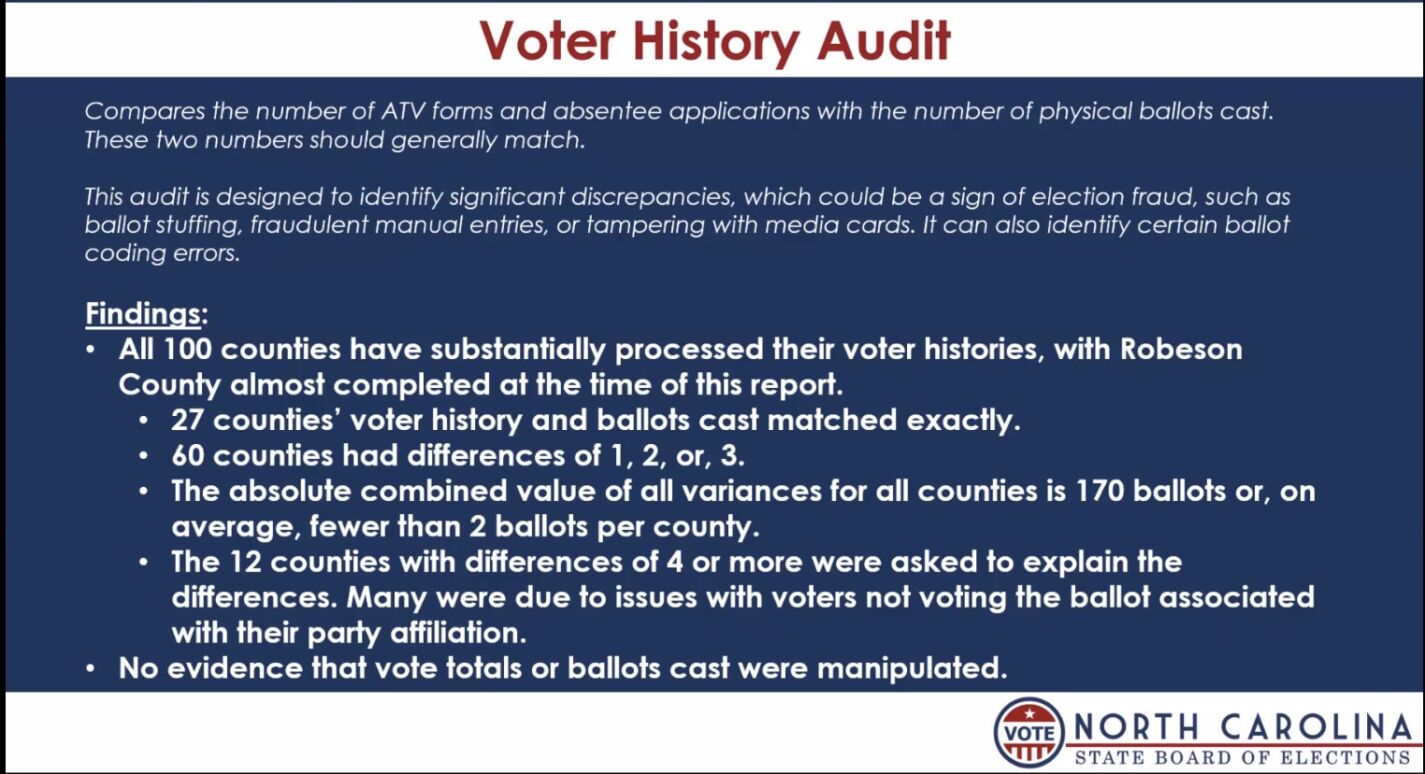
All 100 counties have completed their voter histories except Roberson County, which is almost complete. There were 27 counties with voter history and ballots that matched exactly. Sixty counties had differences of one, two, or three, and 12 counties had differences of four or more. Brinson Bell said they are working with those counties to understand why, but in most cases, it is related to things like voters not wanting to vote on the ballot associated with their party affiliation. There are variances of 170 ballots or fewer than two ballots per county, with differences between voter history and ballots cast.
The Sample Audit, which has been required since state law implemented it in 2006, checks the accuracy of the equipment.
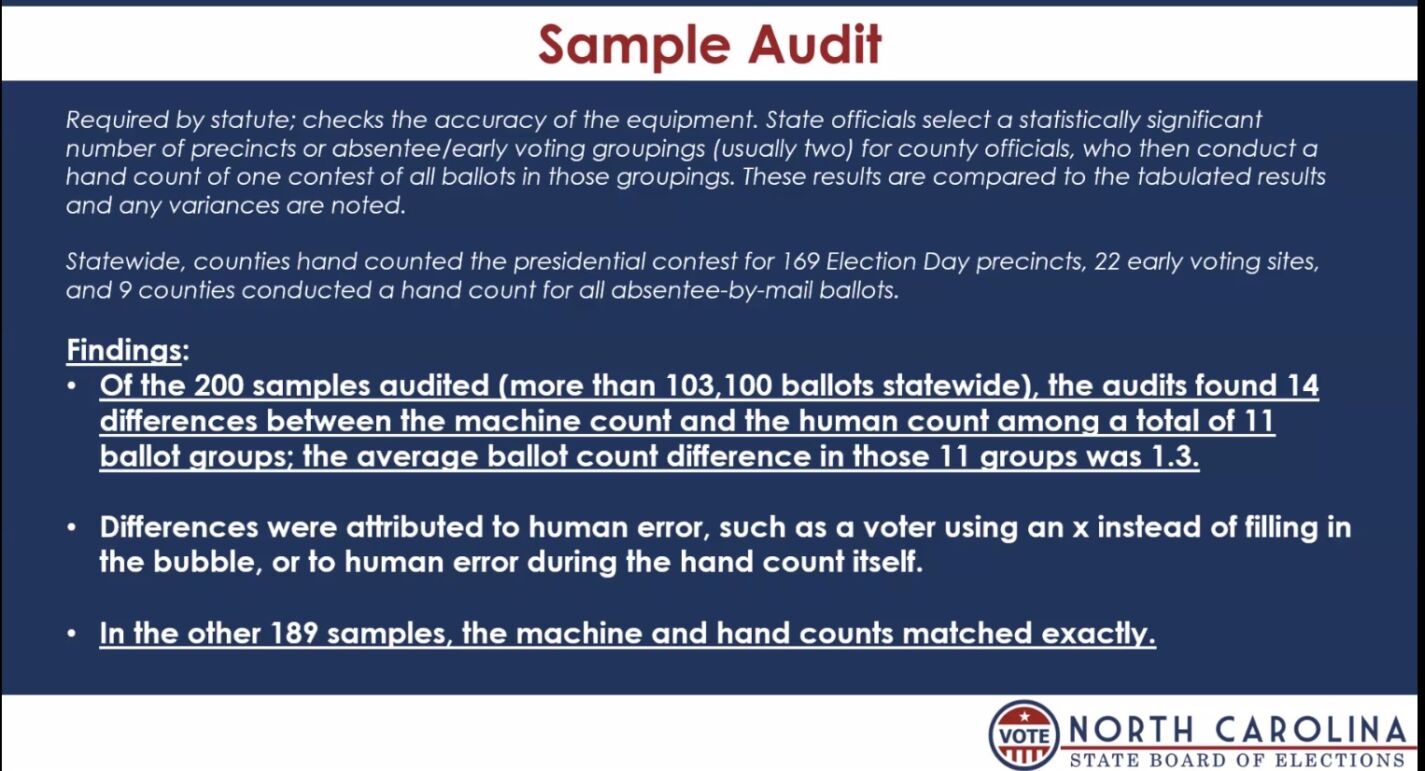
Statewide, counties hand counted the presidential contest for 169 Election Day precincts, 22 early voting sites, and nine counties conducted a hand count for all absentee-by-mail ballots.
For the 2024 primary, of the 200 samples audited (more than 103,100 ballots statewide), the audits found 14 differences between the machine count and the human count among a total of 11 ballot groups. The average ballot count difference in those 11 groups was 1.3.
Differences were attributed to human error, such as a voter using an x instead of filling in the bubble, or to human error during the hand count.
In the other 189 samples, the machine and hand counts matched exactly.
There are three pending protests in NC Senate District 41 and House Districts 73 and 82 and a recount for a county commissioner in District 5 in Robeson County.
The protests do not concern how the ballots are counted, but they do concern some other irregularity alleged about the election, which doesn’t impede the board’s voting to certify the primary.
“In today’s environment, it’s extraordinarily important that the public have faith in what we do and the more steps we can take to be sure that members of the public believe that the vote count is appropriate and we’re doing what we’re supposed to do in the preservation of democracy,” said Alan Hirsch, board chairman.
With the exception of the Robeson County Commissioner District 5 race, the board voted unanimously to certify the 2024 primary election.
The board also voted in favor of holding the second primary runoff election on May 14 in the race for the Republican nominations for Lt. Gov. with Hal Weatherman and Jim O’Neill; the state auditor’s race with Jack Clark and Dave Boliek, and US CD-13 race between Kelly Daughtry and Brad Knott.